HILLINGDON UNITARY DEVELOPMENT PLAN - London Borough ...
HILLINGDON UNITARY DEVELOPMENT PLAN - London Borough ...
HILLINGDON UNITARY DEVELOPMENT PLAN - London Borough ...
You also want an ePaper? Increase the reach of your titles
YUMPU automatically turns print PDFs into web optimized ePapers that Google loves.
13.17 In defining land which should or should not be included for the purposes of MIN3 regard has been<br />
had to guidance contained within MPG14. While this MPG deals principally with the Environment Act<br />
Review, a useful definition on what constitutes restored land is found at para. 23; namely, that it is land<br />
which has been satisfactorily restored and where aftercare conditions have been complied with. Use of this<br />
definition in the implementation of MIN3 ensures that it is only land which is truly restored which can be<br />
ignored, i.e. land where there has been full compliance with all restoration and aftercare requirements.<br />
13.18 In applying Policy MIN3 the Minerals Planning Authority will regard the following categories of<br />
land as being ‘subject to planning permission but where full restoration is yet to be completed’:<br />
(1) land with an extant although as yet unimplemented planning permission for mineral<br />
extraction and/or waste disposal;<br />
(2) land with planning permission for mineral extraction and/or waste disposal where the<br />
permission has been implemented;<br />
(3) land exhausted of mineral but where waste disposal is taking place or will take place<br />
under an extant planning permission;<br />
(4) land used for activities ancillary to mineral extraction and/or waste disposal operations<br />
e.g. processing plant, value added plant, silt ponds, haul roads and soil bunds; in other<br />
words, all other features which would not be there were it not for the mineral extraction<br />
and/or waste disposal operations;<br />
(5) land subject to a planning permission for mineral extraction and/or waste disposal which<br />
is to remain unexcavated but which is not currently being farmed; in other words land<br />
which were it not for the mineral extraction and/or waste disposal operations would<br />
otherwise be in agricultural use;<br />
(6) land where soils have been reinstated but which is not yet in aftercare or where the five<br />
year aftercare period has yet to be completed.<br />
The following land will be excluded from MIN3: Land where soils have been reinstated and is either out of<br />
the five year aftercare period or where there was never an aftercare requirement. This may include parts of<br />
an active mineral extraction and/or waste disposal site where progressive restoration is taking place.<br />
An annual monitoring report will be produced to show the extent of land falling within the ambit of Policy<br />
MIN3. The land so included will be defined on a plan accompanying that report.<br />
The Relationship of Sand and Gravel Extraction to Agriculture<br />
13.19 Agriculture remains the most extensive use of those areas containing unworked deposits of sand<br />
and gravel. It also remains the most extensive use of land restored since the early 1970's after mineral<br />
working. Although restoration for other afteruses, notably playing fields, has become more commom the<br />
Local Planning Authority attaches great importance to supporting agriculture (see paras 3.23 - 3.26) and<br />
where mineral working would conflict with the ability to sustain the competitive edge of agriculture the<br />
agricultural interest will be paramount. The primary means of assessing the success of mineral working<br />
restoration is a comparison of the existing agricultural land classification prior to working with that likely<br />
to be attained within the five years statutory aftercare period, having regard also to any further<br />
improvement which may occur subsequently.<br />
13.20 Paragraph 2.6 of PPG7 identifies agricultural land of Grades 1, 2 and 3a quality as the best and<br />
most versatile agricultural land and states that Minerals Planning Authorities should give considerable<br />
weight to protecting such land. Modern restoration practices (detailed in MPG7) have resulted in improved<br />
restoration performance overall, although within Hillingdon consistently high standards have only been<br />
demonstrated on those sites restored with waste which is for all practical purposes completely inert and<br />
stable. Restoration using non-inert waste is more difficult and has implications in terms of landfill gas<br />
generation, leachate generation and differential settlement, all of which could potentially have direct or<br />
indirect affects on the quality of restoration which is likely to be achieved. In promoting developments<br />
which involve restoration of the best and most versatile agricultural land using non-inert wastes, applicants<br />
will need to demonstrate that the use of such wastes will not prejudice the return of the land to its pre-<br />
<strong>London</strong> <strong>Borough</strong> of Hillingdon Unitary Development Plan
















